The Spanish Privateer takes otome action to the high seas
The Spanish Privateer is an indie otome that released on September 16 of 2022. The title first appeared as an entry in itch.io’s Otome Game Jam of 2018 and saw more attention after a successful Kickstarter campaign.
The Spanish Privateer is a historical otome with a pirate motif, which is an underrated and underutilised premise for the genre — there are only 11 in this subgenre as far as localised/English translated titles are concerned at the time of writing. It’s not to be missed if you are interested in romance and all things pirate-themed.
As SinSisters Studios’ very first game release, it is an extremely impressive one to establish themselves with. Despite obvious budget limitations – no voice acting being the only majorly noticeable one – The Spanish Privateer’s asking price of £11.39 provides excellent value considering the sheer quality and amount of material there is to enjoy here. While the game is estimated to be between 12-20 hours, it actually took me 31 hours to complete the game due to its amount of attainable achievements (21 in total), all 17 endings and the various challenging choices along the way.
The title does not understay or overstay its welcome however, with no stone going unturned in terms of setups and storylines, making for an extremely satisfying overall story and package. It is a splendid piece of interactive literature that truly captures its early 17th Century setting and its major themes; it’s bound to delight fans of the otome genre for its polish and refinement of staple tropes within it.
Thank you to SinSisters Studios for the review code.
The otome heroine character perfected
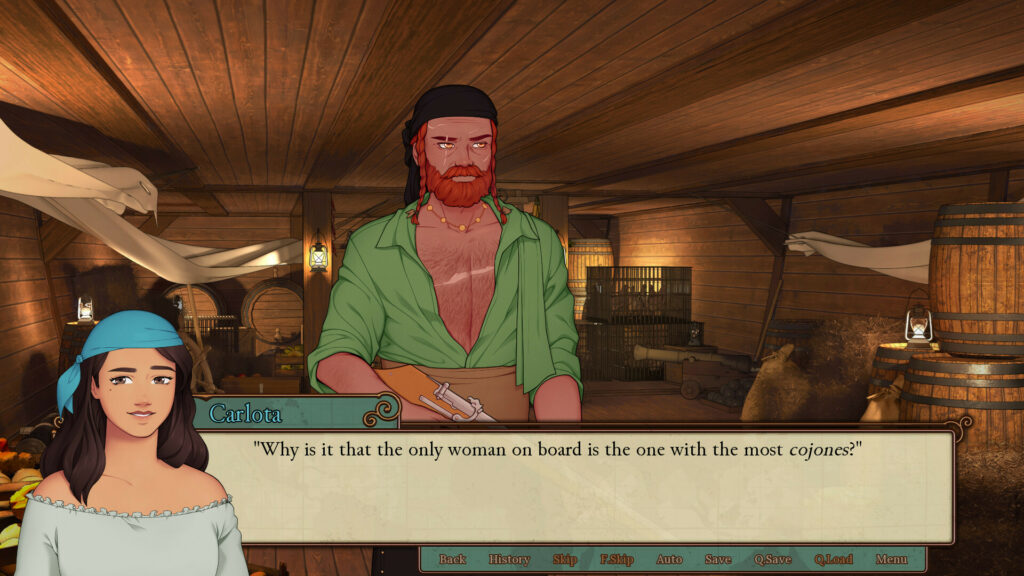
Heroine Isabel Carlota de Castilla (who cannot be renamed) is an 18 year old runaway who is escaping from her comfy and luxurious lifestyle and family due to an impending forced, unwanted marriage. With no desire to have her fate sealed to a man three times her age, Carlota is driven to make a life for herself. This is the driving force in her goals and agency in the game’s common route – which happens to be quite short – as well as the initial scenes of the love interest routes.
It’s a refreshing take on the otome heroine, allowing her to take the reins of her own life and its direction from the get-go, and actually committing to this through all of the decisions you get to make on the path to either success or failure. Carlota is a prime example of the heroine archetype perfected; she is her own character with a distinct origin story and her own goals — and this continues to be important even in the love interests’ routes.
At the same time, her personality is one that can be shaped, making for an excellent balance of a well-established character who can still be influenced by the player’s input when the time calls for it. Depending on your selections, Carlota’s personality can be shaped into three personality groups: diplomatic, polite and subdued; bold, aggressive and daring; or witty, easy-going and facetious. This, in turn, changes up dialogue, characters’ opinions towards Carlota, and the most important factor – the potential of hitting a bad ending.
It’s all a balancing act when taking control of Carlota, so if you’re seeking a happy ending it’s important to take note of how the opinions of the crewmembers towards Carlota evolve due to your selections. Endings can be abrupt, sometimes even resulting in Carlota’s untimely demise, or being forced out of the crew and ship and right back into the life she wants to escape from.
She is a heroine who truly grows across the routes as she becomes more independent, capable and an overall better person for what she experiences.
The events we see her live through and develop from opens her eyes up to possibilities that her sheltered lifestyle did not allow her to consider or understand. This makes for a heroine who is delightful to get to know as her journey progresses; Carlota is someone you actively root for. You want to see her truly become a part of the crow and belong on the ship; to be able to find a new home where she can be happier.
Character complexities done right across the board
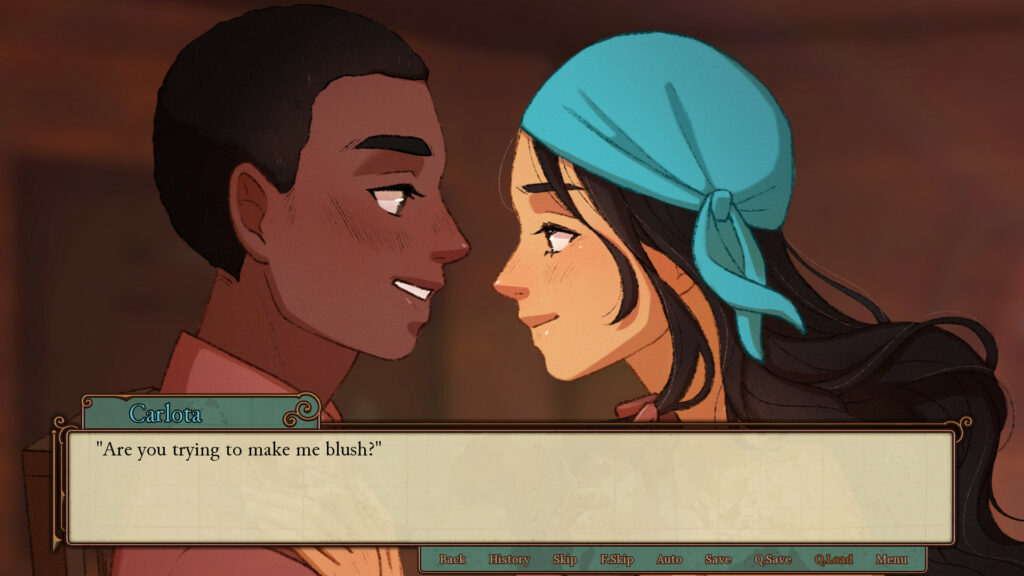
Before we really get into that, we should heap some praise on the game’s characters sooner rather than later. While Carlota certainty steals the show for the most part, all named characters of The Spanish Privateer bring something to the table to leave a lasting impression. With interesting backstories and happenings for even the most minor of characters, the attention to detail here adds a layer of complexity and realism to the game’s world, societal functions and a sense of depth to the cast.
Writing that intertwines the characters makes the story all the more thought provoking and reflective. Characters’ personal conflicts and the way in which they deal with the lives they lead juxtapose and play off each other exquisitely. On that note however, some of these named and memorable characters do not have sprites, which is a bit of a shame; The Spanish Privateer could have been elevated just a bit more by us being able to see them when their input is as notable as it is, especially when it affects and relates to the main cast.
When it comes to its three love interests, The Spanish Privateer shows how quality over quantity is what matters most. The flirtatious bard Lark; the stoic first mate Flint; and the dependable captain Rico are the biggest pulls of the game upon first glance. With their varying personalities and as one of the most diverse love interest pools within any otome to date – Lark is half-Scottish, half-Spanish, Rico originates from Puerto Rico, and Flint is a black character with origins that aren’t made explicit – the neat character arcs for all three routes makes each one all that more unique and exciting.
No lessons learnt are ever the same, and with notable themes such as becoming more open, honest and genuine, accepting and being sure of yourself and learning how to trust again are just a few examples of what each route represents. Each guy also happens to be extremely loveable and charismatic in their own way, even if they appear to be as standoffish as Flint does initially – did someone order a tsundere?
Overall, the love interests have worked hard to get where they are already but manage to continue in growing once they bond with Carlota. This makes for an engaging assemblage regardless of the route taken but made even better by going into the intricacies of their pasts and character complexities.
A wonderful balancing of all things needed for an otome to succeed
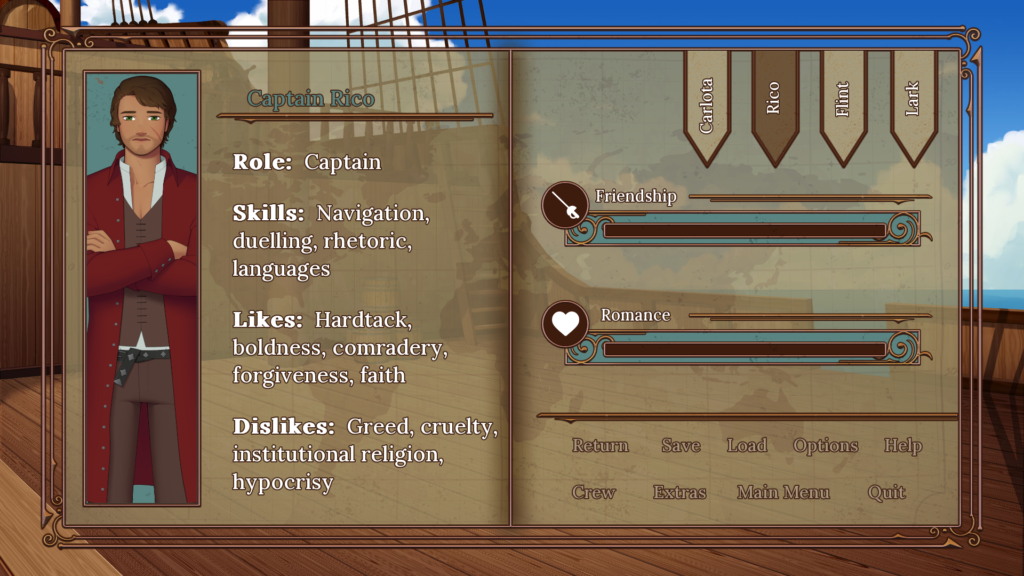
There is a genuinely challenging progression system in the title for an otome. Players must make a good first impression with the crew in the common route alone. There is encouragement to put an equal amount of effort into getting to know everyone in the game across the common route, which bleeds into certain routes. It makes every choice all that more important to consider, since while watching Carlota snap back at misogynistic remarks and sticking up for herself are highly entertaining, the question of whether it’s the correct approach for the situation always lingers.
This makes for an otome that is genuinely challenging in terms of what choices seem to be “correct” at face value. As game’s press kit page describes, “The Spanish Privateer balances the serious examination of the early 17th century with plenty of levity and tender moments” — and it certainly delivers exactly that. The Spanish Privateer does not deviate from the exact time and setting it is based in, and includes some heavier subject matter throughout. The game comes with a handy content warnings page to allow players to consider if it is suitable for them, which is always a plus.
It goes without saying that the attention to detail, as well as the clear amount of research that has gone into the key aspects of the worldbuilding and characters’ hardships only ever helps to deepen the complexity and depth of its various storylines. The intricacies and heavy realities of said characters are counterbalanced by the sweetest moments in the game, regardless of route. Within each one, the confession scenes are especially extremely sweet and endearing.
While this tends to be saved for the routes’ finale before the credits roll, the moments of Carlota’s feelings being realised as expressed by the writing is especially wonderful. The relationship progression for each route also differs from one another, making each one refreshing for how distinctive each blossoming relationship Carlota has with her love interest of choice can be. This allows for each relationship to have its own unique high points and dynamics compared to the others.
Romantic progression is natural and organic, featuring a nice build up as we learn where characters’ “walls” are and their vulnerabilities are acknowledged; Carlota chips away at their defences as she confides in them herself.
Nothing happens too soon even if there is teasing, and the eventual opening up of both Carlota and the selected love interest makes for great signalling of their awakening romantic interest. If I had to highlight just one route however, it would have to be Lark’s – his back-and-forths with Carlota are hilarious. They act like an old married couple right from the get-go with all the teasing and good natured, snide jabs.
A fully realised privateer world: easy to ogle at but hard to say goodbye to
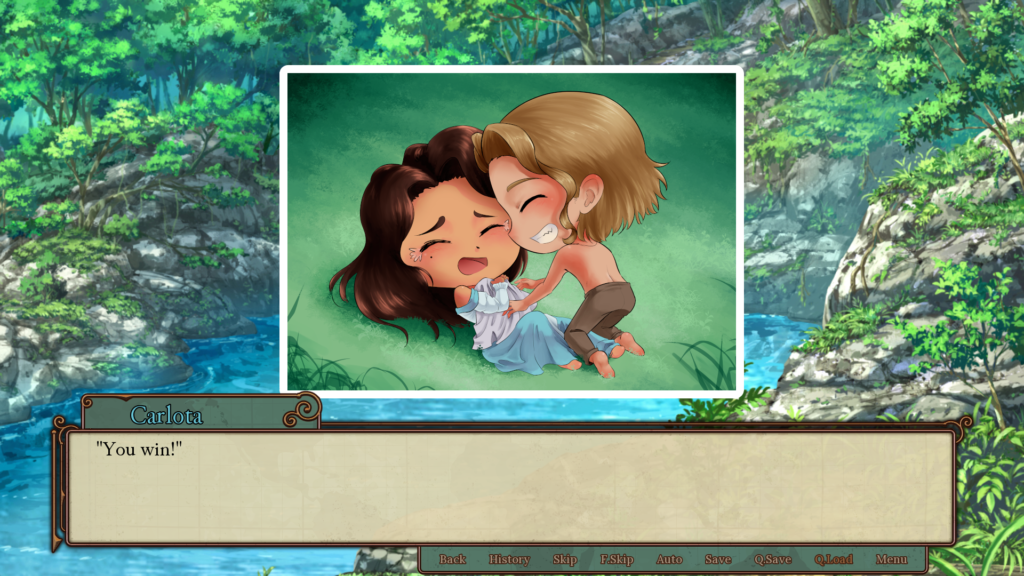
Despite all the praise, the game is not without some minor faults however. While some foreign and archaic words are clickable to make a short explanation of the term appear in the text box, some words and concepts that could do with additional explanation are somewhat skimmed by.
This problem is compounded if you don’t turn on the optional underlining of foreign and archaic words, making for a rather confusing time if you’re completely blind to what is and is not explained. Coming out of the game and resorting to Google takes me out of the immersion at times due to this.
When it comes to its UI, there’s a few more little nitpicks. Since the game puts a strong emphasis on how you develop Carlota’s personality as well as your “love” and “friendship” levels with each character, continually going in and out of the main menu to refer to these meters is a bit of a chore, especially when replaying a route. If this was displayed in a drop-down menu or a pop-up interface, it would have felt smoother and less imposing.
Additionally, while all its CGs are wonderful and varied in terms of changing expressions, certain details are not always on-point when it comes to its backgrounds. As one example, the tavern room background illustration always shows two beds, even when the situation mentions only one bed being in the room. This is hardly game-breaking, but when the game has such attention to detail elsewhere, it’s a bit of a shame to see simple mistakes like this.
On the flip side, its chibi CGs are always fun and engaging to see get unlocked since whenever they grace your screen, you know that you have chosen a dialogue/action choice wisely.
Furthermore, Carlota as well as the love interests frequently change in and out of their various outfits, which further illustrates just how well realised and presented the game’s scenarios are. If I had just one major suggestion to make for SinSisters Studios’ future games, it is with the trimming or editing of certain monologues. Occasionally, they sometimes have a tendency to be too descriptive, making characters feel ingenuine and speak out of character. I found this mostly only relevant to Rico, especially in the final scenes of his route.
At this point, I’m clutching at straws here because The Spanish Privateer made me insanely happy for how much polish and effort clearly went into it. The most minor of all events and dialogue concerning the most glossed over aspects of life on sea in any other piece of work – such as what happens when nature calls or what happens when a woman’s time of the month hits – is greatly appreciated.
Conclusion
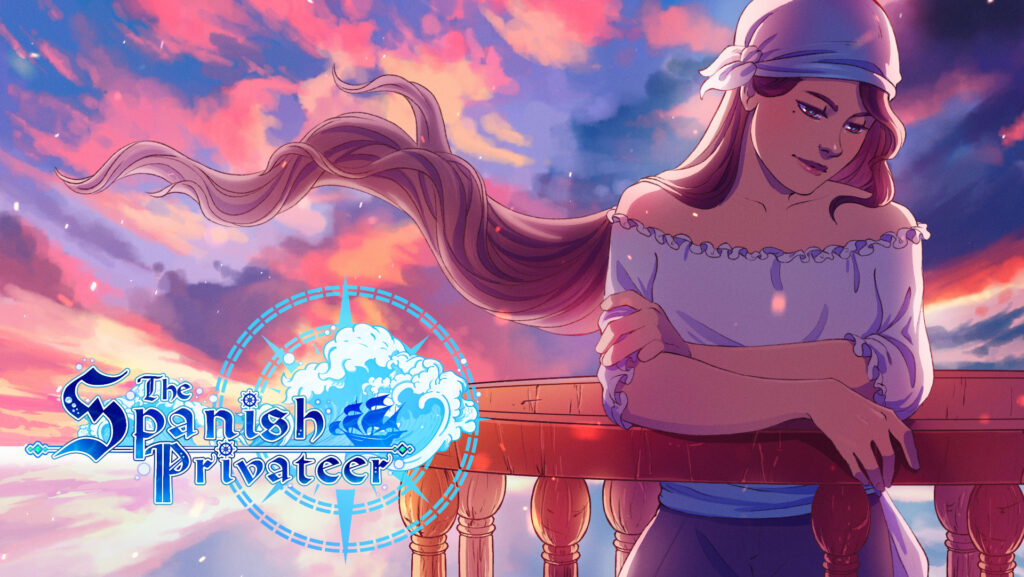
The Spanish Privateer is your next must-play otome game, so far as I’m concerned.
The game’s characters, with their emotional, hard hitting backstories, still allow breathing room for revelations to occur alongside humorous dialogue and hilarious scenes; there’s a few instances of breaking the fourth wall and emphasising comedic value with sprite work.
For a game that is all about making a new start for yourself whilst accepting the hurdles you have to face when doing so, it is captivating in how grounded and heartfelt it is whilst keeping things light-hearted but also poignant and deep. To be able to dual-wield both outcomes is worth every bit of high praise – let alone being an extremely entertaining journey to the high seas at face value.
With fully realised characters who lead complex lives with some of the most engaging character arcs to come from an indie otome, The Spanish Privateer is truly a riveting time. I have come out of this game wiser and happier for having experienced it, so be sure to check out the game via either itch.io or Steam.
Join The Discussion
Rice Digital Discord
Rice Digital Twitter
Rice Digital Facebook
Or write us a letter for the Rice Digital Friday Letters Page by clicking here!
Disclosure: Some links in this article may be affiliate links, which means we may earn a small commission if you make a purchase after clicking on them. This is at no additional cost to you and helps support Rice Digital!
- Sigh of the Abyss: Shadow Bonds – Prologue Review - October 7, 2023
- Is She The Wolf? is wickedly addicting TV - October 6, 2023
- The steady consumption of Slow Damage - October 5, 2023






